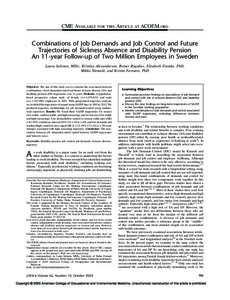Combinations of Job Demands and Job Control and Future Trajectories of Sickness Absence and Disability Pension An 11-year Follow-up of Two Million Employees in Sweden
Farrants Kristin; Niemelä Mikko; Salonen Laura; Alexanderson Kristina; Framke Elisabeth; Rugulies Reiner
https://urn.fi/URN:NBN:fi-fe2021042825467
Tiivistelmä
Objective: The aim of this study was to examine the association between combinations of job demands/control and future sickness absence (SA) and disability pension (DP) trajectories over 11 years.
Methods: A population-based prospective cohort study of female (n = 1,079,631) and male (n = 1,107,999) employees in 2001. With group-based trajectory analysis, we modeled the trajectories of annual mean SA/DP days in 2002 to 2012. We predicted trajectory memberships for job demands/control using multinomial regression.
Results: We found three SA/DP trajectories for women (low stable, medium stable, and high increasing) and two for men (low stable and high increasing). Low demands/low control in women [odds ratio (OR) 1.42; 95% confidence interval (95% CI) 1.38 to 1.45], and low demands and medium/high control in men (equal OR of 1.23; 95% CI 1.18 to 1.28) were strongly associated with high increasing trajectory.
Conclusion: The associations between job demands/control varied between SA/DP trajectories and between sexes.
Kokoelmat
- Rinnakkaistallenteet [19207]
